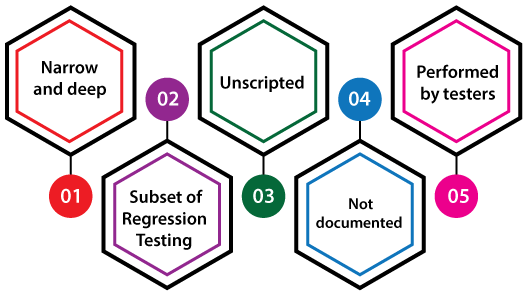Back to: Software Testing Tutorials
Sanity Testing
In this article, I am going to discuss Sanity Testing. Please read our previous article where we discussed Smoke Testing. At the end of this article, you will understand the following important pointers which are related to Sanity Testing.
- What is Sanity Testing?
- What is the Functionality of Sanity Testing?
- What are the Objectives of Sanity Testing?
- What are the Features of Sanity Testing?
- Why do we need Sanity Testing?
- What are the Priorities of Sanity Testing?
- Explain the Process of Sanity Testing
- When to Perform Sanity Testing?
- Example of Sanity Testing
- What are the Advantages of Sanity Testing?
- What are the Disadvantages of Sanity Testing?
What is Sanity Testing?
Sanity testing is a sort of software testing that seeks to swiftly assess whether or not a new software build’s fundamental functionality is operating as intended. Prior to performing the complete regression testing, it is typically done on builds that are still in the early phases of development. Sanity testing is usually limited in scope and concentrates on key features rather than trying to find every potential error or flaw in the system.

Before conducting additional testing, it is a quick and easy technique to make sure the software is operating as planned. Sanity testing makes ensuring that the associated modules are not impacted by changes to the code or functions. As a result, it can only be used on connected modules that could be affected. In other words, sanity testing is carried out to ensure that all issues have been resolved and that these alterations haven’t introduced any new ones.
What is the Functionality of Sanity Testing?
Sanity testing’s purpose is to check that a software build’s essential features are operating as intended without thoroughly examining the system as a whole. Sanity testing often comprises checking that the software’s most crucial and commonly used functions are operating as intended. Sanity testing’s objective is to immediately spot any significant problems that would make the software unusable rather than to find every potential error or bug in the system. Verifying the user interface, data input and output, and other crucial software components may also be a part of sanity testing.
Sanity testing has a narrow scope and is often carried out on early-stage builds before comprehensive regression testing is carried out. Sanity testing’s main purpose is to ascertain whether the modifications or the new features operate as planned. In order to save time and money, the testing team will reject the software if the sanity test is unsuccessful. It is only carried out once the software product has passed the smoke test and been approved for additional testing by the Quality Assurance team.
What are the Objectives of Sanity Testing?
Implementing sanity testing is most important for achieving the following goals:
- Executing the sanity tests is done primarily to determine whether the proposed features behave inconsistently as expected. To save the costs and complexity of more rigorous testing, the build is rejected if the sanity test fails.
- Sanity testing is used to ensure that any modifications don’t alter the functionality of the software as it is currently used.
- Additionally, it confirms that the recently introduced functionality and components are accurate.
What are the Features of Sanity Testing?
We must learn about their attribute as well as a number of other components in order to comprehend the fundamentals of sanity testing procedures. As a result, the following are some of the crucial aspects of sanity testing:

- A subset of Regression Testing: Sanity testing is a subset of regression testing and focuses on the more narrowly focused area of the application.
- Unscripted: Sanity testing is typically not conducted according to a script.
- Not Documented: Sanity testing is frequently not recorded.
- Narrow and Deep: Sanity testing is a confined and in-depth approach to testing in which a small set of functionalities is thoroughly examined.
- Performed by Testers: Sanity testing is typically carried out by test engineers.
Why do we need Sanity Testing?
You could wonder why sanity tests are necessary if we already run end-to-end testing or carry out other sorts of tests that verify each functionality of the software program. This has a pretty straightforward solution. You should be aware that each software testing technique is necessary depending on the situation. Sanity testing is essential to verify the software application’s new and essential functionality:
- Save a ton of time: Sanity testing ensures that software programs are thoroughly tested. There is no need to conduct any rigorous testing, such as end-to-end testing or regression testing, in a scenario where sanity testing fails. As a result, testing takes much less time because, in cases of poor software quality, defects discovered in a software program are promptly forwarded to the developers to fix.
- Quick assessment: The test process can be completed faster. It is narrowly focused on particular features or functionality that need testing. Additionally, we don’t need test cases or scripts to run sanity checks. Instead, we perform a sanity test that swiftly assesses a software application using an unanticipated intuitive way.
- Reduce unnecessary work: By doing sanity testing on the software application under test, we can significantly reduce unnecessary effort. It aids in determining whether or not we must conduct more software testing. Additionally, since the concerns are forwarded straight to developers for resolution, testers are not compelled to report them.
- Regression testing is made better since it enables testers to confirm major application errors after updates. Regression testing basically entails running a set of test cases again to make sure the program still functions correctly after incorporating the modifications.
- Find compilation and deployment problems: Let’s use an example to better understand this. Imagine the user interface would be unattractive if developers neglected to compile the build, including all resource files. The development group can overlook any deployment notes. This may result in the deployed software program failing to load and operate in a test environment. We can rapidly find and fix such problems with sanity checks.
- Give a brief update on the software release state: Sanity checks provide information on the state of the software release, enabling effective test planning in the future. For instance, if the sanity test is unsuccessful, the subsequent task in the development of the application is delayed and the defects in the software release are corrected first.
What are the Priorities of Sanity Testing?
Developers and testers can validate their use of sanity tests in the software development life cycle. Here are the sanity test’s two most important criteria in accordance with that.
- Sanity test cases give high software project value to improve user experience by utilizing standard features.
- Regression tests are used to determine which sanity test cases should be used to satisfy the SRS.
Explain the Process of Sanity Testing
Sanity testing is primarily used to look for faults or inaccurate results that don’t exist in component methods. Additionally, make sure that the newly introduced features won’t interfere with the functionality of the already existing features. As a result, in order to gradually adopt the sanity testing method, we must take the following steps:

Step 1: Identification
Identification is the initial step in the sanity testing process, where we look for newly added features and components as well as changes made to the code to address bugs.
Step 2: Evaluation
Following the identification phase, we will assess the newly developed components, and attributes, and make any necessary modifications to ensure that they function as intended and appropriately for the provided criteria.
Step 3: Testing
After successfully completing the identification and evaluation steps, we will proceed to the testing phase. In this stage, we check to see if all the related parameters, elements, and components of the previously analyzed and modified ones are functioning properly.
If each of the aforementioned processes is successful, the build can go through more exhaustive and in-depth testing, and the release can be approved for extensive testing.
When to Perform Sanity Testing?
One or more crucial features of the testing software applications are the subject of the sanity test. It must be carried out in various circumstances. These are a few of them:
- Whenever there are minor modifications made to the application’s code.
- When newly additional features are prepared for integration into the software program.
- A new build is produced after a number of regression tests are completed.
- Include bug fixes.
- Prior to deployment in production.
- The software application’s functionalities before merging them.
Example of Sanity Testing
The login page, home page, user profile page, user registration page, etc. are the main components of an e-commerce project. The login page has a flaw since the password field allows for fewer than four alpha-numeric characters despite the requirement that it not be less than eight. As a result, the testing team informs the development team of the fault so they can fix it. The development team then corrects the reported flaw and submits it for approval to the testing team. The testing team then determines whether or not the improvements made are functioning properly. If it affects other relevant functionalities, that is also determined. The user profile page now has a feature that allows the password to be updated. The login page and the profile page are both evaluated as part of sanity testing to make sure that the checks are functioning properly at both locations.
What are the Advantages of Sanity Testing?
The following are a few dynamic advantages of sanity testing:
- Sanity testing is easy to understand and apply.
- It helps us spot any compilation or deployment problems.
- It is less expensive than other types of software testing.
- It aids in quickly locating faults in the fundamental functionality.
- Sanity testing can be carried out more quickly because no paperwork is necessary.
- Because sanity testing only concentrated on one or a small number of functional areas, it helped us avoid wasting time and effort on superfluous testing.
- Finding the missing dependent objects is made easier with sanity testing.
What are the Disadvantages of Sanity Testing?
The following are sanity testing’s disadvantages:
- If the developers do not adhere to the design structure level, it has become a very difficult procedure for them to comprehend how to address the flaws discovered during sanity testing.
- Sanity testing does not apply to all test cases.
- Only the application’s statement and functions are highlighted.
- We don’t have any references for the future because the sanity test is not preplanned.
- Finding any additional components got difficult because sanity testing is only done for a small number of features.
In the next article, I am going to discuss Static Testing. Here, in this article, I try to explain Sanity Testing. I hope you enjoy this Sanity Testing article.
